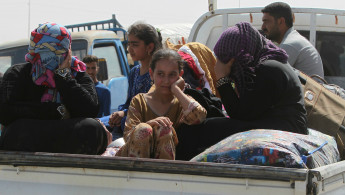IS in Iraq: A year of death and destruction
A year after the Islamic State (IS) group launched a brutally effective offensive, Iraq is struggling to survive as a unified nation, gripped by seemingly endless violence, sectarianism and humanitarian tragedy.
IS began the offensive on June 9, 2014, and overran a third of the country, declaring it and areas in neighbouring Syria a "caliphate" and carrying out atrocities from beheadings and mass executions to enslavement and rape.
The group has been driven out of some areas, but still holds much of western Iraq and remain able to defeat Baghdad's forces and gain new territory despite a year of heavy fighting and some 4,000 strikes carried out in a 10-month US-led air campaign.
The Syrian civil war served as an incubator and training ground for IS, while widespread anger among Iraqi Sunni Arabs, who accused the Shia-led government of marginalising and targeting their minority community, helped the group succeed.
"The underlying causes of (the) IS rise are still there," said Patrick Skinner, an analyst with the Soufan Group intelligence consultancy.
"And that means IS will remain, perhaps kicked out periodically from place to place but still in the national bloodstream like a septic infection," he said.
IS overran Iraq's second city Mosul in less than 24 hours last year, despite being heavily outnumbered, then pushed south with allied militant groups, raising fears that Baghdad itself could fall.
 |
|
| A year of IS in Iraq: Click here for larger image |
Destroying Iraq's past and future
The borders, boundaries and demographics of Iraq have been drastically changed over the past year.
As IS advanced and security forces fled, Iraq's autonomous Kurdish region seized some disputed areas and consolidated its grip on others, helping it realise long-held territorial goals that Baghdad will find extremely difficult to reverse.
And widespread displacement - nearly three million people since the beginning of 2014 - has altered Iraq's demographic map, with Sunni Arabs fleeing to predominantly Shia and Kurdish areas.
The conflict has drawn Washington back into a quagmire it thought it had escaped, making a mockery of its goal of Iraq being a stable, democratic ally in the region and leaving it with little to show for a hugely costly nearly nine-year war.
The US is carrying out airstrikes against the extremists and has sent thousands of soldiers to train Iraqi forces, and an international coalition has followed suit.
But IS has proven highly resilient and last month even seized the city of Ramadi, the strategically important capital of Anbar province, which Iraqi forces had defended for over a year.
The fighting to drive IS back has wrecked town after town in Sunni-majority areas, leaving behind smashed houses, ruined shops and felled palm trees.
The damage will cause further resentment if it is not repaired, but doing so will add strain to an already cash-strapped government.
The destruction inherent in any war has been worsened by the burning and looting of homes and shops by some militiamen, which has contributed to mistrust of these forces.
And the war is destroying Iraq's past as well as its future, with IS smashing and bombing world-renowned historic sites, including Nimrud and Hatra, and looting priceless artefacts to fund its operations.





 Follow the Middle East's top stories in English at The New Arab on Google News
Follow the Middle East's top stories in English at The New Arab on Google News


